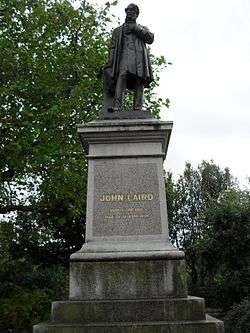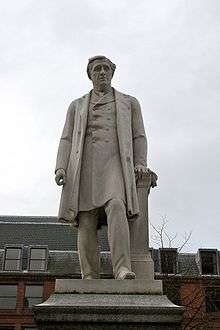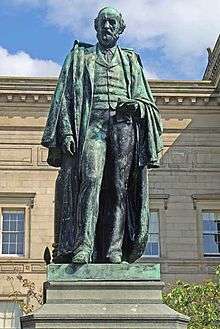Albert Bruce-Joy
| Albert Bruce-Joy | |
|---|---|
| Born |
Joy, Albert Bruce 21 August 1842 Dublin |
| Died |
22 July 1924 Shottermill |
| Nationality | Irish |
| Known for | Sculpture |
Albert Bruce-Joy (21 August 1842 – 22 July 1924) was an Irish sculptor working in England. His original surname was Joy but he became known under his hyphenated name Bruce-Joy later in life. He was the brother of the painter George W. Joy.
Biography
Son of William Bruce Joy, MD, Bruce-Joy was born in Dublin but educated in Offenbach, Paris and at King's College London.[1]
He trained as a sculptor with John Henry Foley at the National Art Training School, South Kensington, and the Royal Academy Schools. He began exhibiting at the Royal Academy from 1866 onwards.[2] In 1867 he gave an address in Rome[3] where he is said to have spent three years.
After his return to London, he took over the commission for a statue of Robert James Graves for the Royal College of Physicians in Dublin. This was originally given to the late John Foley (died 1874) who had previously finished three statues for the College. This marked the start of his specialisation in portrait statues, busts and medallions which were praised at the time for their likeness, and for which he is now mostly known.
Bruce-Joy built his house in Shottermill near Haslemere in 1891, and travelled to America twice in his life.[4]
Works
(a detailed list is given at the University of Glasgow's database[3])
- Statue of John Laird (1877) in Birkenhead.[5]
- Statue of James Whiteside (1880) in St Patrick's Cathedral, Dublin.[6]
- Statue of Gladstone (1882) in front of Bow Church, Bow, London.[7]
- Statues of John Bright (1891),[8] and Oliver Heywood (1894)[9][10] in Albert Square, Manchester.
- Statue of Alexander Balfour (1905) in St John's Gardens, Liverpool.[11]
- Statue of William Harvey, Surgeon, The Leas, Folkestone, Kent.
Gallery
-

John Laird in Birkenhead
-

James Whiteside in St Patrick's Cathedral, Dublin
-

Statue of Gladstone in Bow, London
-

John Bright in Manchester's Albert Square
-

Oliver Heywood in Manchester's Albert Square
-

Alexander Balfour in St John's Gardens, Liverpool
References
- ↑ Kate Newmann, in: Dictionary of Ulster Biography.
- ↑ "Albert Bruce-Joy (1842-1924), Sculptor". National Portrait Gallery. Retrieved 1 January 2012.
- 1 2 Albert Bruce Joy ARHA, RHA, Mapping the Practice and Profession of Sculpture in Britain and Ireland 1851-1951, University of Glasgow History of Art and HATII, online database 2011, accessed 04 Dec 2012.
- ↑ Victorian Web.
- ↑ Statue of John Laird, Public Monument and Sculpture Association, archived from the original on 9 February 2012, retrieved 1 January 2012
- ↑ James Whiteside by Albert Bruce-Joy, The Victorian Web, retrieved 1 January 2012
- ↑ "London's Hidden History Bow Church". Modern Gent. Retrieved 2012-01-01.
- ↑ "John Bright". Manchester Art Gallery. 2009. Retrieved 1 January 2012.
- ↑ "Oliver Heywood". Manchester Art Gallery. 2009. Retrieved 1 January 2012.
- ↑ Wyke, Terry (2004). Public Sculpture of Greater Manchester. Liverpool University Press. p. 21. ISBN 0-85323-567-8.
- ↑ Alexander Balfour by Albert Bruce-Joy, The Victorian Web, retrieved 1 January 2012
| Wikimedia Commons has media related to Albert Bruce-Joy. |
Further reading
- Gerhard Bissell, Joy, Albert Bruce, in: Allgemeines Künstlerlexikon, vol. 78, 2013.